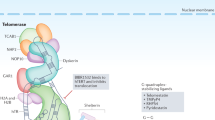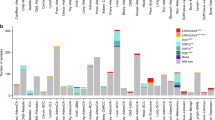Abstract
Telomeres protect chromosome ends from fusion, degradation and recombination. Loss of telomere function has opposite effects on tumorigenesis: apoptosis, which inhibits tumour growth, and genomic instability, which accelerates tumour formation. Here we describe a new mechanism by which short telomeres inhibit tumorigenesis through interference with oncogenic translocations. In mice that are null for both ataxia-telangiectasia-mutated (Atm) and telomerase RNA (mTR), the first generation (G1) Atm−/− mTR−/− mice have a lower rate of tumour formation than Atm−/− mTR+/+ mice. These Atm−/− mTR−/− G1 tumours show no increase in either apoptosis or overall genomic instability. Strikingly, the tumours show a high fraction of translocations containing telomere signals at the translocation junctions. Translocations of the T-cell receptors on chromosome 14, which initiate tumorigenesis, were interrupted by fusion with telomeres. Telomere repeats were also detected at the translocation junctions in pre-malignant thymocytes. We propose that telomere fusion to DNA double-strand breaks competes with the generation of oncogenic translocations and thus reduces tumour formation.
This is a preview of subscription content, access via your institution
Access options
Subscribe to this journal
Receive 12 print issues and online access
$209.00 per year
only $17.42 per issue
Buy this article
- Purchase on Springer Link
- Instant access to full article PDF
Prices may be subject to local taxes which are calculated during checkout





Similar content being viewed by others
References
Mills, K. D., Ferguson, D. O. & Alt, F. W. The role of DNA breaks in genomic instability and tumorigenesis. Immunol. Rev. 194, 77–95 (2003).
Shiloh, Y. ATM and related protein kinases: safeguarding genome integrity. Nature Rev. Cancer 3, 155–168 (2003).
Barlow, C. et al. Atm-deficient mice: a paradigm of ataxia telangiectasia. Cell 86, 159–171 (1996).
Liyanage, M. et al. Abnormal rearrangement within the α/δ T-cell receptor locus in lymphomas from Atm-deficient mice. Blood 96, 1940–1946 (2000).
Greenwell, P. W. et al. TEL1, a gene involved in controlling telomere length in S. cerevisiae, is homologous to the human ataxia telangiectasia gene. Cell 82, 823–829 (1995).
Morrow, D. M., Tagle, D. A., Shiloh, Y., Collins, F. S. & Hieter, P. TEL1, an S. cerevisiae homolog of the human gene mutated in ataxia telangiectasia, is functionally related to the yeast checkpoint gene MEC1. Cell 82, 831–840 (1995).
Myung, K., Chen, C. & Kolodner, R. D. Multiple pathways cooperate in the suppression of genome instability in Saccharomyces cerevisiae. Nature 411, 1073–1076 (2001).
DuBois, M. L., Haimberger, Z. W., McIntosh, M. W. & Gottschling, D. E. A quantitative assay for telomere protection in Saccharomyces cerevisiae. Genetics 161, 995–1013 (2002).
Chan, S. W. & Blackburn, E. H. Telomerase and ATM/Tel1p protect telomeres from nonhomologous end joining. Mol. Cell 11, 1379–1387 (2003).
Metcalfe, J. A. et al. Accelerated telomere shortening in ataxia telangiectasia. Nature Genet. 13, 350–353 (1996).
Wong, K. K. et al. Telomere dysfunction and Atm deficiency compromises organ homeostasis and accelerates ageing. Nature 421, 643–648 (2003).
Qi, L. et al. Short telomeres and ataxia-telangiectasia mutated deficiency cooperatively increase telomere dysfunction and suppress tumorigenesis. Cancer Res. 63, 8188–8196 (2003).
Maser, R. S. & DePinho, R. A. Connecting chromosomes, crisis, and cancer. Science 297, 565–569 (2002).
Feldser, D. M., Hackett, J. A. & Greider, C. W. Telomere dysfunction and the initiation of genome instability. Nature Rev. Cancer 3, 623–627 (2003).
Greenberg, R. A. et al. Short dysfunctional telomeres impair tumorigenesis in the INK4a(δ2/3) cancer-prone mouse. Cell 97, 515–525 (1999).
Rudolph, K. L., Millard, M., Bosenberg, M. W. & DePinho, R. A. Telomere dysfunction and evolution of intestinal carcinoma in mice and humans. Nature Genet. 28, 155–159 (2001).
Gonzalez-Suarez, E., Samper, E., Flores, J. M. & Blasco, M. A. Telomerase-deficient mice with short telomeres are resistant to skin tumorigenesis. Nature Genet. 26, 114–117 (2000).
Rudolph, K. L. et al. Longevity, stress response, and cancer in aging telomerase-deficient mice. Cell 96, 701–712 (1999).
Chin, L. et al. p53 deficiency rescues the adverse effects of telomere loss and cooperates with telomere dysfunction to accelerate carcinogenesis. Cell 97, 527–538 (1999).
Artandi, S. E. et al. Telomere dysfunction promotes non-reciprocal translocations and epithelial cancers in mice. Nature 406, 641–645 (2000).
Lustig, A. J. Clues to catastrophic telomere loss in mammals from yeast telomere rapid deletion. Nature Rev. Genet. 4, 916–923 (2003).
Henson, J. D., Neumann, A. A., Yeager, T. R. & Reddel, R. R. Alternative lengthening of telomeres in mammalian cells. Oncogene 21, 598–610 (2002).
Hemann, M. T., Strong, M. A., Hao, L. Y. & Greider, C. W. The shortest telomere, not average telomere length, is critical for cell viability and chromosome stability. Cell 107, 67–77 (2001).
Latre, L. et al. Shortened telomeres join to DNA breaks interfering with their correct repair. Exp. Cell Res. 287, 282–288 (2003).
Bailey, S. M., Cornforth, M. N., Ullrich, R. L. & Goodwin, E. H. Dysfunctional mammalian telomeres join with DNA double-strand breaks. DNA Repair (Amst.) 3, 349–357 (2004).
Richardson, C. & Jasin, M. Frequent chromosomal translocations induced by DNA double-strand breaks. Nature 405, 697–700 (2000).
Bassing, C. H., Swat, W. & Alt, F. W. The mechanism and regulation of chromosomal V(D)J recombination. Cell 109 Suppl., S45–S55 (2002).
Kaplan, E. L. & Meier, P. Nonparametric estimation from incomplete observations. J. Am. Stat. Assoc. 53, 457–481 (1958).
Lansdorp, P. M. et al. Heterogeneity in telomere length of human chromosomes. Hum. Mol. Genet. 5, 685–691 (1996).
Liyanage, M. et al. Multicolour spectral karyotyping of mouse chromosomes. Nature Genet. 14, 312–315 (1996).
Acknowledgements
We are grateful to T. Ried and M. Difilippantonio for providing TCRα/δ BAC clones; M. Montminy for support; B. Todd and L. Y. Hao for assistance; R. Thompson for statistic consultation; Greider laboratory members, J. Boeke, G. Seydoux, G. Stetten, and R. Yarrington for critical reading of the manuscript. L.Q. is the 2nd Dr George Santos Researcher and Fellow of the Leukemia and Lymphoma Society (5532-03). B.O.K. is supported by a NIH training grant RR07002. This work is supported by NIH grants CA16519 (to C.W.G.) and RR00171 (to D.L.H.).
Author information
Authors and Affiliations
Corresponding author
Ethics declarations
Competing interests
The authors declare no competing financial interests.
Supplementary information
Supplementary Information
Supplementary figures S1 and S2; supplementary tables S1 and S2 (PDF 216 kb)
Rights and permissions
About this article
Cite this article
Qi, L., Strong, M., Karim, B. et al. Telomere fusion to chromosome breaks reduces oncogenic translocations and tumour formation. Nat Cell Biol 7, 706–711 (2005). https://doi.org/10.1038/ncb1276
Received:
Accepted:
Published:
Issue Date:
DOI: https://doi.org/10.1038/ncb1276
This article is cited by
-
Telomeres in cancer: tumour suppression and genome instability
Nature Reviews Molecular Cell Biology (2017)
-
Cooperation between p53 and the telomere-protecting shelterin component Pot1a in endometrial carcinogenesis
Oncogene (2013)
-
PARP1 and DNA-PKcs synergize to suppress p53 mutation and telomere fusions during T-lineage lymphomagenesis
Oncogene (2013)
-
Telomere Shortening and Alzheimer’s Disease
NeuroMolecular Medicine (2013)
-
Unstabilized DNA breaks in HTLV-1 Tax expressing cells correlate with functional targeting of Ku80, not PKcs, XRCC4, or H2AX
Cell & Bioscience (2012)



